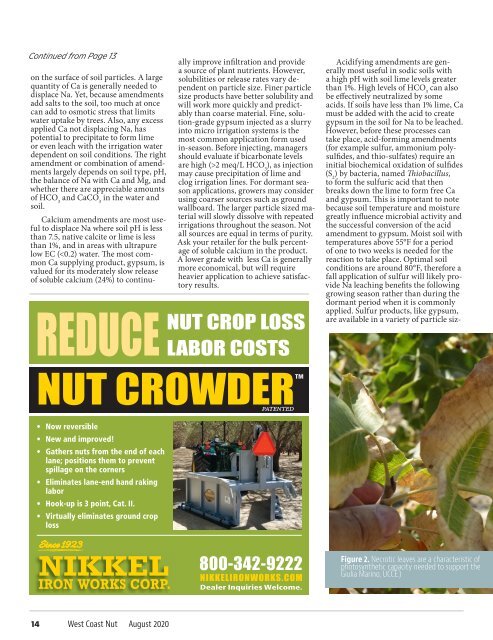Create successful ePaper yourself
Turn your PDF publications into a flip-book with our unique Google optimized e-Paper software.
Continued from Page 13<br />
on the surface of soil particles. A large<br />
quantity of Ca is generally needed to<br />
displace Na. Yet, because amendments<br />
add salts to the soil, too much at once<br />
can add to osmotic stress that limits<br />
water uptake by trees. Also, any excess<br />
applied Ca not displacing Na, has<br />
potential to precipitate to form lime<br />
or even leach with the irrigation water<br />
dependent on soil conditions. The right<br />
amendment or combination of amendments<br />
largely depends on soil type, pH,<br />
the balance of Na with Ca and Mg, and<br />
whether there are appreciable amounts<br />
of HCO 3<br />
and CaCO 3<br />
in the water and<br />
soil.<br />
Calcium amendments are most useful<br />
to displace Na where soil pH is less<br />
than 7.5, native calcite or lime is less<br />
than 1%, and in areas with ultrapure<br />
low EC (2 meq/L HCO 3<br />
), as injection<br />
may cause precipitation of lime and<br />
clog irrigation lines. For dormant season<br />
applications, growers may consider<br />
using coarser sources such as ground<br />
wallboard. The larger particle sized material<br />
will slowly dissolve with repeated<br />
irrigations throughout the season. Not<br />
all sources are equal in terms of purity.<br />
Ask your retailer for the bulk percentage<br />
of soluble calcium in the product.<br />
A lower grade with less Ca is generally<br />
more economical, but will require<br />
heavier application to achieve satisfactory<br />
results.<br />
NUT CROP LOSS<br />
REDUCE LABOR COSTS<br />
Acidifying amendments are generally<br />
most useful in sodic soils with<br />
a high pH with soil lime levels greater<br />
than 1%. High levels of HCO 3<br />
can also<br />
be effectively neutralized by some<br />
acids. If soils have less than 1% lime, Ca<br />
must be added with the acid to create<br />
gypsum in the soil for Na to be leached.<br />
However, before these processes can<br />
take place, acid-forming amendments<br />
(for example sulfur, ammonium polysulfides,<br />
and thio-sulfates) require an<br />
initial biochemical oxidation of sulfides<br />
(S 2<br />
) by bacteria, named Thiobacillus,<br />
to form the sulfuric acid that then<br />
breaks down the lime to form free Ca<br />
and gypsum. This is important to note<br />
because soil temperature and moisture<br />
greatly influence microbial activity and<br />
the successful conversion of the acid<br />
amendment to gypsum. Moist soil with<br />
temperatures above 55°F for a period<br />
of one to two weeks is needed for the<br />
reaction to take place. Optimal soil<br />
conditions are around 80°F, therefore a<br />
fall application of sulfur will likely provide<br />
Na leaching benefits the following<br />
growing season rather than during the<br />
dormant period when it is commonly<br />
applied. Sulfur products, like gypsum,<br />
are available in a variety of particle siz-<br />
NUT CROWDERTM<br />
• Now reversible<br />
• New and improved!<br />
• Gathers nuts from the end of each<br />
lane; positions them to prevent<br />
spillage on the corners<br />
• Eliminates lane-end hand raking<br />
labor<br />
• Hook-up is 3 point, Cat. II.<br />
• Virtually eliminates ground crop<br />
loss<br />
PATENTED<br />
TM<br />
NIKKEL<br />
IRON WORKS CORP.<br />
800-342-9222<br />
NIKKELIRONWORKS.COM<br />
Dealer Inquiries Welcome.<br />
Figure 2. Necrotic leaves are a characteristic of<br />
photosynthetic capacity needed to support the<br />
Giulia Marino, UCCE.)<br />
14 West Coast Nut <strong>August</strong> <strong>2020</strong>


















